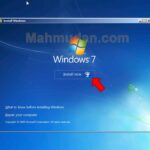Hyper-V in Windows 7 is a topic that raises questions for many loyal users. you may ask: is it possible to enable this modern virtualization feature on the legendary OS?
This article will thoroughly examine the realities surrounding Hyper-V on Windows-7 and the virtualization solutions that you can implement.
List of contents
What is Hyper-V?

Hyper-V is a hardware virtualization product created by Microsoft that functions to create and run versions of computer software, which is called a virtual computer.
Each virtual machine acts like a complete computer, run the operating system and programs. Can run more than one virtual machine on the same hardware at the same time
With Hyper-V you can install and run other operating systems such as Windows 7 on your computer so it looks as if you have several different computers. Hyper-V is even capable of running non-Windows operating systems. you can create a CentOS-7 virtual machine with Hyper-V.
Uses of Hyper-V
With Hyper-V, allows you to:
- Runs software that requires an earlier version of Windows or non-Windows operating systems.
- Experiment with other operating systems. Hyper-V makes it easy to create and delete different operating systems.
- Test the software on multiple operating systems using multiple virtual computers. With Hyper-V, You can run them all on one desktop or laptop computer. These virtual machines can be exported and then imported into other Hyper-V systems, including Azure.
Hyper-V Requirements:
To be able to use Hyper-V, several requirements must be met:
- Windows 10 Enterprise, Pro, or Education
- 64-bit processor with Second Level Address Translation (SLAT).
- CPU support for VM Monitor Mode Extension (VT-c on Intel CPUs).
- Minimum memory 4 GB
Facts about Hyper-V in Windows 7
You may be wondering: “Is it possible to enable Hyper-V in Windows-7 to run a virtual machine?”
Firm Answer: Hyper-V on Windows-7 Cannot Be Enabled
The reality of Hyper-V in Windows-7 is something that must be clearly understood: this feature cannot be enabled as a hypervisor on your system. Here's a detailed explanation of why this isn't possible:
- Unsupported Architecture
Hyper-V capabilities in Windows-7 are not natively available due to architectural limitations. Hyper-V is a type-1 hypervisor technology that is integrated into operating systems starting from Windows 8 and specific server editions. The Windows-7 architecture was not designed to support this technology. - The Actual Function of RSAT
Understanding of Microsoft Remote Server Administration Tools (RSAT) for Hyper-V on Windows-7 is often mistaken. RSAT does not enable Hyper-V locally. This tool only provides a management console (Hyper-V Manager) to control the Hyper-V server running on the computerother (such as Windows Server or Windows 10/11) remotely. - Access Has Been Disconnected
Since Microsoft stopped support for Windows-7, package RSAT compatible official is no longer available for download. Searching for and installing the archive version is not recommended, because apart from being risky, You still need onehost Hyper-V running on a separate machine.
Virtualization Alternatives in Windows 7
Although Hyper-V on Windows-7 is not an option, Your needs for creating and running virtual machines can still be met with other solutions that are powerful and user-friendly.
1. Oracle VM VirtualBox (Key Recommendations)
- Superiority: Free, open-source, light, and very easy to use. The community support is extensive.
- Usage: Ideal for home users, student, and developers who want to get started with virtualization.
- Link: Download the Windows-7 compatible version from the VirtualBox archive site.
2. VMware Workstation Player
- Superiority: Stable and high performance, with seamless integration to the host system via VMware Tools.
- Usage: Suitable for small business environments or users who prioritize stability and performance.
- Notes: Free version (Player) available. Make sure to download a release that supports Windows 7.
3. VMware Workstation Pro (Old Version)
- If you have a legacy license for VMware Workstation (version 15.x or earlier), This software will run optimally on Windows-7 with complete features.
A Quick Start

As a quick first step, You can download VirtualBox and use it as an alternative to create virtual machines in Windows-7. you can create a CentOS virtual machine with VirtualBox on Windows in minutes.
VirtualBox supports a variety of guest operating system including but not limited to Windows (NT 4.0, 2000, XP, Server 2003, Vista, 7, 8, Windows 10 and Windows 11), DOS/Windows 3.x, Linux (2.4, 2.6, 3.x, 4.x, 5.x and 6.x), Solaris and OpenSolaris, OS/2, OpenBSD, NetBSD dan FreeBSD.
Conclusion
So, although Hyper-V on Windows-7 is not a possibility, the path to virtualization is by no means closed. By switching to software like VirtualBox or VMware, Instead, you get a more accessible and fully compatible solution for the Windows-7 environment.
Instead of trying to find an impossible way to activate Hyper-V, take the time to learn about one of the recommended alternatives. You will find that your virtualization needs can be met very well, even outside the Hyper-V ecosystem.
Hopefully this information is useful.







